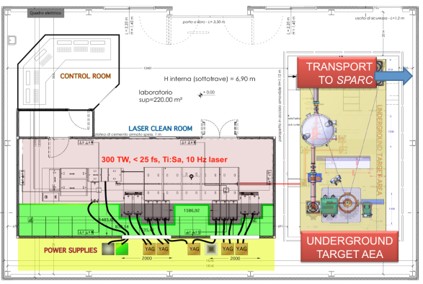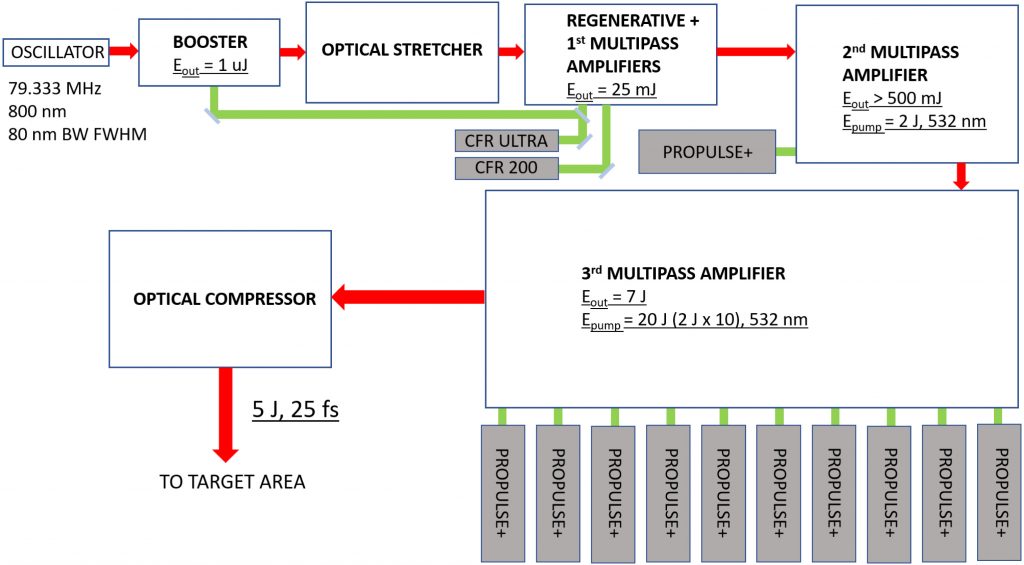
FLAME laboratory layout
FLAME is a compact femtosecond laser system able to provide pulses with a maximum energy of 7 J, temporally compressed down to 25 fs, with a peak power of 200 TW and 10 Hz repetition rate. The system is a Titanium–Sapphire laser based on the so-called Chirped Pulse Amplification (CPA) scheme (the same scheme awarded by the 2018 Nobel prize).
The FLAME laser CPA chain starts with a femtosecond laser oscillator, delivering 10 fs, 4 nJ pulses at 80 MHz. A Pockels cell, acting as pulse picker, brings the oscillator output repetition rate down to 10 Hz. In order to improve Amplified Spontaneous Emission (ASE) contrast ratio (less than 10−9), the beam is amplified at µJ level by a compact multipass amplifier (booster).
After a saturable absorber, removing the residual ASE, the pulses are temporally elongated by means of an optical stretcher. This unit is based on an all-reflective triplet combination Offner, composed of two spherical concentric mirrors: the first mirror is concave and the second is convex. It is characterized by a complete symmetry, therefore only the symmetrical aberrations can appear (spherical aberration and astigmatism). This combination has no on-axes coma and exhibits no chromatic aberration (read here for more details). An acousto-optic programmable dispersive filter, used as a phase modulator to pre-compensate for dispersion and phase distortions, is installed at the stetcher exit, where the pulse has a temporal length of about 600 ps.

FLAME laser optical layout.
Then, the amplification chain starts: (1) a regenerative amplifier produces about 1 mJ TEM00 pulses, two Pockels cells are used to improve the contrast ratio and an acousto-optic programmable gain control filter compensates for gain narrowing of the spectrum; (2) three multi-pass amplifiers bring the energy up to 7 J before compression. They are pumped by Nd–YAG lasers; the last amplifier is cryo-cooled to avoid thermal effects on the crystal (50x50x20) mm3.
An optical compressor, in a four-passes scheme, installed in a vacuum chamber at 10−6 mbar, is able to recompress the pulse down to fs without any residual spatial chirp. Temporal measurement are performed by means of an APE SPIDER. A series of remotely controlled mirrors are used to transport the beam from the compressor up to the target area.
Here, a dedicated experimental chamber is installed. The laser is focused by means of a 15°, gold-coated, Off-Axis Parabolic (OAP) mirror, reaching a transverse rms size of 5 µm. The transverse size measurement is performed with a Basler Scout scA640-70gm CCD camera equipped with a 35 mm microscope objective, with a resolution of 3 µm/pixel.

Typical transverse spot size in the target area
Besides the 200 TW line, a probe laser pulse is also available in target area, as a small amount of the main beam energy (about 10%) is split before the cryo-cooled amplifier. Then, a dedicated compressor shortens the pulse down to 30 fs, while a delay line synchronizes the two beams, compensating for the longer optical path of the main laser inside the last amplification stage. This second laser line is usually employed in pump-and-probe experiments: e.g. to measure the plasma density in laser wakefield acceleration (LWFA) runs, to detect THz field with EOS. The fine synchronization between the two beams is achieved by measuring the second harmonic generation occurring in an $\alpha$-cut beta barium borate (BBO) crystal.
Publication highlights:
- “The FLAME laser at SPARC_LAB“, F. G. Bisesto et al., Nucl. Instr. Meth. Phys. Res. A vol. 909 (2018) pag. 452, doi: 10.1016/j.nima.2018.02.027
- “Vulcan and Flame ultra-short pulses characterization by grog algorithm”, M. Galletti et al., J. of Instrum. vol. 14 (2019) pag. C02005, doi: 10.1088/1748-0221/14/02/C02005
- “Overview and Recent Developments of the Frascati Laser for Acceleration and Multidisciplinary Experiments Laser Facility at SPARC_LAB”, M. Galletti et al., Appl. Sci., vol. 14 (2024), pag 8619, doi: 10.3390/app14198619
Contact person: M. P. Anania, Maria.Pia.Anania@lnf.infn.it, tel. (+39) 069403 2947

